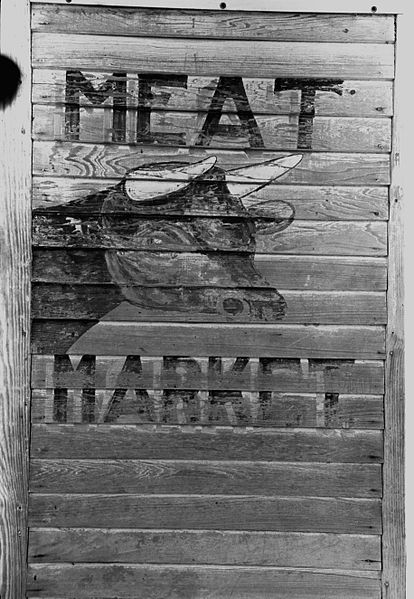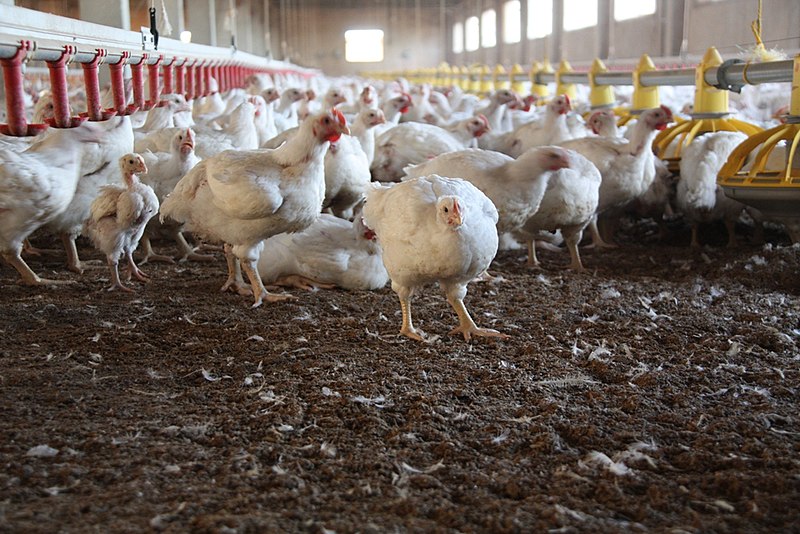The Perfect Pork Chop Society: A Review of Food, Inc
DONALD O’DONOVAN
Food, Inc
Directed by Robert Kenner
This important and incisive documentary will show you what’s on the end of your fork and tell you how it got there.
The inspiration for “Food, Inc” came from Eric Schlosser’s landmark investigative book, Fast Food Nation, and The Omnivore’s Dilemmaby Michael Pollan, author of The Botany of Desire. The questions the film raises are basic. Where does our food come from? What goes into our food and on it, in terms of fertilizers, hormones and pesticides? How far does food travel from farm to market, and how much time elapses from harvest to table? How much are food workers paid, and what measures are taken to ensure their health and safety? How are food animals such as cows, pigs and chickens housed, fed and maintained before they’re slaughtered?
The filmmakers take you inside factory farming, to a chicken house packed with some 20,000 chickens that spend their lives in near total darkness, shot full of growth hormones that cause them to bulk up so fast that they can’t take two steps without their overburdened legs collapsing under them. Hold your nose and check your humanity at the door. Later on you’ll visit the feedlots and slaughterhouses and what you’ll see there will make you wish you hadn’t. You’ll also learn just what percentage of your meat is manure.
Well, I don’t want to be one of these people who tells you the whole movie before you see it. Check this film out for yourself. You won’t be disappointed. Appalled, yes. Shocked, of course. Saddened, sickened, disgusted, revolted, outraged, sure, all of that, but not disappointed.
The film’s principal speakers are Eric Schlosser (Fast Food Nation), Michael Pollan (Omnivore’s Dilemma) and Joel Salatin, owner of Polyface Farm in Virginia where natural symbiotic non-factory farming methods have proven to be both sustainable and profitable. These are some very smart guys, and they have a grasp not only of the corporate food situation but of how the factory farming paradigm relates to a larger national paradigm with respect to the political hegemony, Wall Street, the petroleum industry, the military, the pharmaceutical industry and so on—to what might be more succinctly called, in Terence McKenna’s phrase, the Dominator Culture.
Joel Salatin’s words on this subject are worth repeating: “A culture that views a pig as a pile of protoplasmic inanimate structure to be manipulated by whatever creative design the human can foist on that critter, will probably view individuals within its community and other cultures in the community of nations with the same type of disdain and disrespect and controlling type mentality.”
 <
Corn, the basic diet (because it’s cheap and fattening) of beef cattle in America, is unsuitable, it turns out, for the simple reason that cows are herbivores. They’re designed to eat grass, not grain. You and I can eat grass, of course, but we can’t digest it. So how does a cow digest its natural diet of grass? Answer: unlike us primates, cows have an extra stomach called a rumen. The grass they eat goes first to the rumen where it’s fermented, then it’s transferred to a regular stomach like ours where it’s readily digested. Pretty ingenious, huh? But corn, which cows would never eat on their own, doesn't work in the rumen and consequently cows have a hard time digesting corn so they get sick. How sick? Well, what they call feedlot diseases mostly: coccidiosis, enterotoxemia, diahrrea, ulcers, liver disease, pneumonia and so on. The solution? Antibiotics, of course, and other drugs such as Rumensin and Tylosin. Consequently that saran-wrapped New York strip steak you buy at the supermarket is not only tasty and well-marbled, but it also packs enough of a chemical wallop to knock you right into the middle of next week.
But aren’t you and I, the consumers, at least partly to blame for this situation? Of course we are. Unlike her grandmother and great-grandmother, the modern American has no time for cooking. In fact she doesn’t know how to cook, unless you call cooking shoving a TV dinner containing up to 74 ingredients, most of them unpronounceable, into the microwave. Unlike Granny she doesn’t garden or “put by” for the winter months by canning or preserving the garden’s bounty. Doesn’t need to because there are no seasons at the supermarket and everything you find there has a real (and I do mean real) long shelf life, thanks to the miracle of modern chemistry. An avid Raiders or Chargers or Denver Broncos fan, she can under no circumstances miss a game, and later on in the evening, there’s “Jeopardy” and “Wheel of Fortune,” and of course the meticulously choreographed and edited evening news. With this hefty schedule of “activities” (six hours of TV at last count), members of the McNugget Generation simply don’t have time to cook.
<
Corn, the basic diet (because it’s cheap and fattening) of beef cattle in America, is unsuitable, it turns out, for the simple reason that cows are herbivores. They’re designed to eat grass, not grain. You and I can eat grass, of course, but we can’t digest it. So how does a cow digest its natural diet of grass? Answer: unlike us primates, cows have an extra stomach called a rumen. The grass they eat goes first to the rumen where it’s fermented, then it’s transferred to a regular stomach like ours where it’s readily digested. Pretty ingenious, huh? But corn, which cows would never eat on their own, doesn't work in the rumen and consequently cows have a hard time digesting corn so they get sick. How sick? Well, what they call feedlot diseases mostly: coccidiosis, enterotoxemia, diahrrea, ulcers, liver disease, pneumonia and so on. The solution? Antibiotics, of course, and other drugs such as Rumensin and Tylosin. Consequently that saran-wrapped New York strip steak you buy at the supermarket is not only tasty and well-marbled, but it also packs enough of a chemical wallop to knock you right into the middle of next week.
But aren’t you and I, the consumers, at least partly to blame for this situation? Of course we are. Unlike her grandmother and great-grandmother, the modern American has no time for cooking. In fact she doesn’t know how to cook, unless you call cooking shoving a TV dinner containing up to 74 ingredients, most of them unpronounceable, into the microwave. Unlike Granny she doesn’t garden or “put by” for the winter months by canning or preserving the garden’s bounty. Doesn’t need to because there are no seasons at the supermarket and everything you find there has a real (and I do mean real) long shelf life, thanks to the miracle of modern chemistry. An avid Raiders or Chargers or Denver Broncos fan, she can under no circumstances miss a game, and later on in the evening, there’s “Jeopardy” and “Wheel of Fortune,” and of course the meticulously choreographed and edited evening news. With this hefty schedule of “activities” (six hours of TV at last count), members of the McNugget Generation simply don’t have time to cook.
Incidentally, 38 ingredients go into the McNugget, which appears to the eye to be simply an appetizing little lump of fried chicken. Included are sodium aluminum phosphate, calcium lactate, dimethylpolysiloxene and butylhydroguinone, derived directly from petroleum, to “help preserve freshness.”
On the plus side, the message of this important film is that supply dictates demand. As consumers, we have the power to decide how we spend our food dollar. The filmmakers encourage us to buy organic whenever we can. But there’s a spot of bother here. “Organic,” as Pollan explains in The Omnivore’s Dilemma, has been co-opted. Numerous factory farms have become “organic” factory farms. In fact, most of the organic produce sold in American markets is now produced by two giant organic factory farms, Earthbound Farm and Grimmway Farms, both located in California. So for the consumer, perhaps “sustainable” and “local” are the more operative words now, rather than “organic.” So what’s a person to do? Buy organic, of course, when you can and if you can afford it. But buy locally, from farmers markets and local grocery stores, and from farmers who practice sustainable agriculture. And—plant a garden and grow at least some of your own food.
Whatever you do, don’t miss Food, Inc’s Special Features. The segment entitled “Designing the Perfect Pork Chop” is a hoot. I had to watch this clip three times before I realized that it wasn’t a satire or a parody, and that the scientists featured are actual scientists and not actors. Yup, it’s real all right. These bozos in their gene kitchen with their beakers of chemicals are entirely serious and they’re pleased as punch about their progress in engineering an animal that will produce the perfect pork chop.
The artifacts a civilization leaves behind are indicative of the character, esthetic sensibilities and spiritual qualities of its citizens. Pharaonic Egypt left us the Pyramids at Giza; the Inca Empire bequeathed us Machu Picchu; ancient India gave us the Taj Mahal, the Hellenistic Age the Parthenon and the European Middle Ages the magnificent Chartres Cathedral. Thus it seems “altogether fitting and proper,” as they say, that the lasting achievement of America, to be viewed by future generations through the lens of history, should be—the Perfect Pork Chop.
Donald O’Donovan wrote the first draft of his novel Night Train (Open Books, 2010) on 23 yellow legal pads while homeless in the streets of LA. His other novels include Tarantula Woman, The Sugarhouse and Highway. An optioned screenwriter and voice actor with film and audio book credits, Donald O’Donovan lives mostly in Los Angeles. He can be reached at: donaldo7777@yahoo.com
Find a list of O’Donovan’s books here and here. See O’Donovan’s other pieces on DDA: The Novel As Graffiti, Cardboard Villages, Simon Rodia, Architect of Dreams, and I Live Under Your Wallpaper
Find O’Donovan’s new novel, Orgasmo, here.





There are no comments at the moment, do you want to add one?
Write a comment